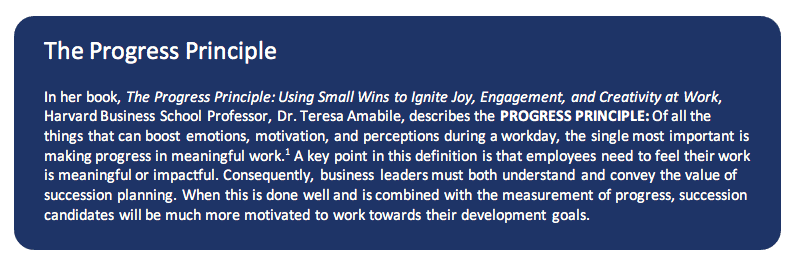Why Measure Succession Planning Progress?
What gets measured, gets managed.
Peter Drucker
Studies show that over 65% of senior managers can’t name their organization’s top priorities. More than that, 80% of small business owners don’t keep track of their goals.[1] It comes as no surprise that succession planning is one of the key strategic areas where leaders fail to set goals and measure progress. As a result, most businesses find themselves scrambling through replacement hiring, rather than truly planning for the future.
In this blog, we’ll discuss the importance of measuring progress on your succession plan and we’ll walk you through how measurement can be used to manage, monitor, and motivate goal achievement.
Measuring to Manage
One of the most compelling reasons to measure succession planning progress is that it significantly increases the probability that goals will be attained. This is particularly true for the talent development stage of succession planning. Here, succession candidates will take part in ongoing development efforts (coaching, stretch assignments, shadowing, training/education, etc.) with the purpose of achieving specific goals. Finding ways to quantify and track progress towards these goals is one of the best ways to ensure they are accomplished. In fact, studies show that:
- Measuring and monitoring coaching clients’ efforts over time makes it more likely that goals will be attained,[2] and lasting behavior change is more likely to occur when progress is monitored over (at least) 8 follow-up sessions.[3],[4]
- Scheduling time to check in with a peer or superior is important for accountability and increases goal completion rates from 65% up to 90%.[5]
- There is a direct correlation between how often progress is monitored, and how likely it is that goals will be attained. The American Psychological Association (APA) also published research showing that success rates for goal attainment are even higher when progress is physically recorded and/or publicly reported.[6]
Measuring to Monitor
One of the key reasons why measurement aids goal attainment, is that it allows teams to monitor progress along the way. It might be easy to assume that once goals are set, progress will be made. In reality, however, we often need to monitor progress to provide accountability along the way.
In addition to providing accountability, monitoring progress allows adjustments to be made. Leaders have the opportunity to pick up the pace, or hone in on specific areas where progress is below target. Measurement therefore provides an up-to-date understanding of development efforts, which guides leaders in their management. Other benefits of measuring to monitor progress include:
- Detecting performance trends
- Understanding levels of capacity and utilization
- Uncovering current and potential future problems
- Changing behavior based on feedback
- Quantifying and comparing success (e.g. across goals, targets, and succession candidates)
- Enabling data-driven, objective decisions

Measuring to Motivate
The other (and arguably most important) reason why measuring progress promotes success is that it can be highly motivating. This is evident in the widespread success of apps that track hours slept, tasks completed, chapters read, or steps taken. Monitoring progress is motivating because it allows people to feel an ongoing sense of accomplishment, rather than delaying satisfaction until a goal is fully attained. In effect, measurement makes it all about the journey, rather than the destination. This notion is critical to the nature of succession planning, because a true succession plan involves ongoing employee development to raise up a successor, rather than simply hiring or promoting on-the-spot.
How SIGMA Can Help
If you’re looking for resources to help you measure progress on your succession plan, we can help! Take a look at SIGMA’s Individual Development Plan for tools to help you structure the development process and facilitate evaluation for individual succession candidates. You can also use our Talent Progress Scorecard to maintain an up-to-date picture of your succession planning progress. For more guidance, take a look at our succession planning training and consulting services here, or contact us below. We would love to hear from you.
[1] Maasik, A. (October 31, 2018). Unless You Track Your Progress, Setting Goals Is a Waste of Effort. Entrepreneur. Retrieved from https://www.entrepreneur.com/article/321532.
[2] Harkin, B., Webb, T. L., Chang, B. P. I., Prestwich, A., Conner, M., Kellar, I., …, & Sheeran, P. (2016). Does monitoring goal progress promote goal attainment? A meta-analysis of the experimental evidence. Psychological Bulletin, 142, 198-229.
[3] Baron, L., & Morin, L. (2010). The impact of executive coaching on self-efficacy related to management soft-skills. Leadership & Organization Development Journal, 31, 18-38.
[4] Sonesh, S. C., Coultas, C. W., Lacerenza, C. N., Marlow, S. L., Benishek, L. E., & Salas, E. (2015). The power of coaching: A meta-analytic investigation. Coaching: An International Journal of Theory, Research and Practice, 8, 73-95.
[5] Oppong, T. (January 16, 2017). This is How to Increase The Odds of Reaching Your Goals by 95%. Mission.Org. Retrieved from https://medium.com/the-mission/the-accountability-effect-a-simple-way-to-achieve-your-goals-and-boost-your-performance-8a07c76ef53a.
[6] American Psychological Association. (October 29, 2015). Frequently monitoring progress toward goals increases chance of success. Science Daily. Retrieved from https://www.sciencedaily.com/releases/2015/10/151029101349.htm.